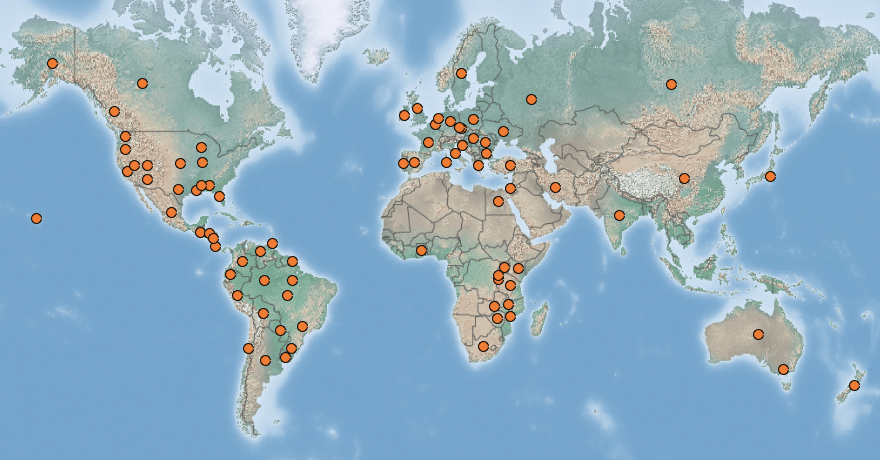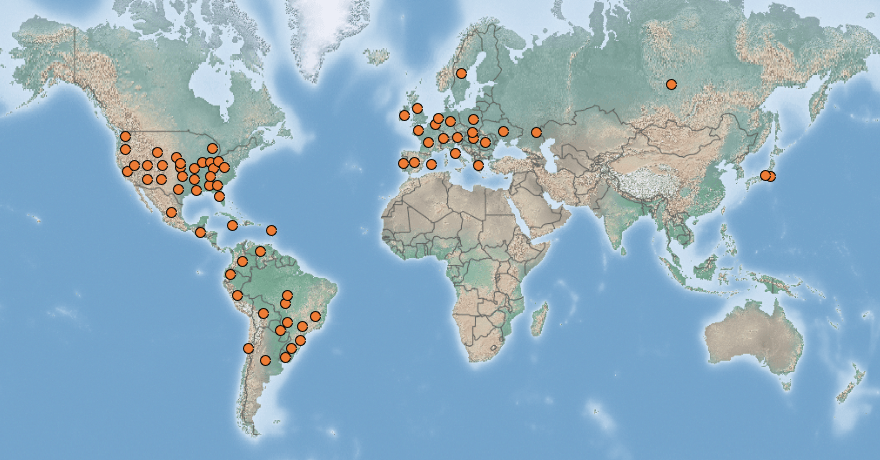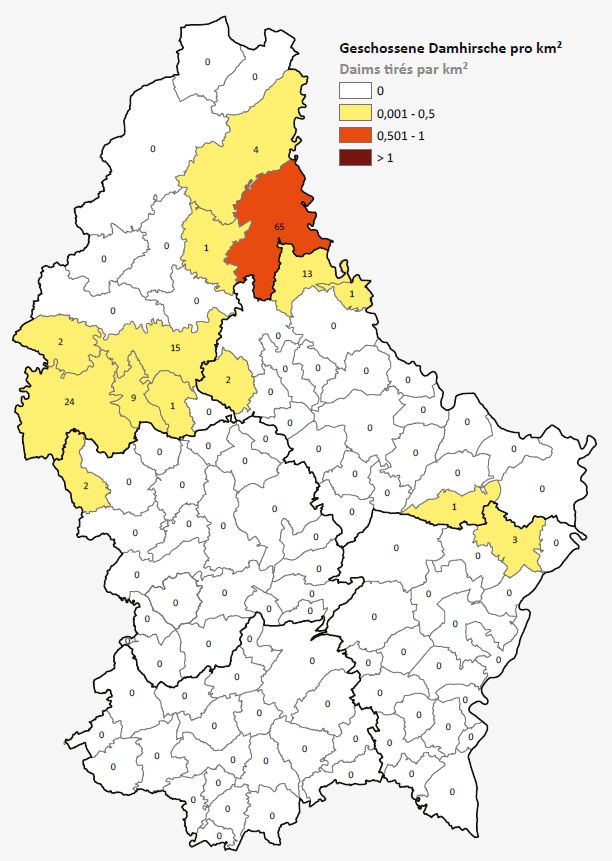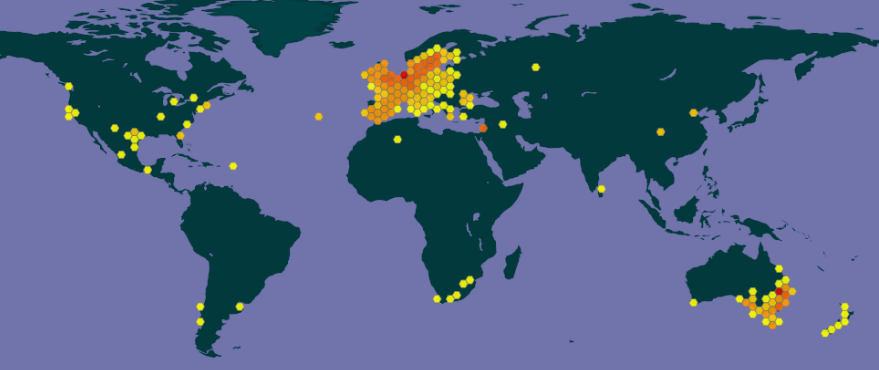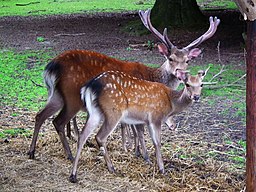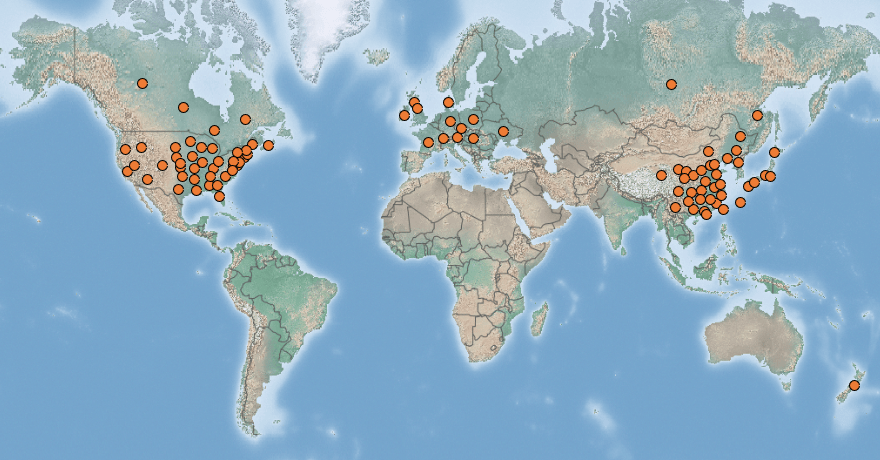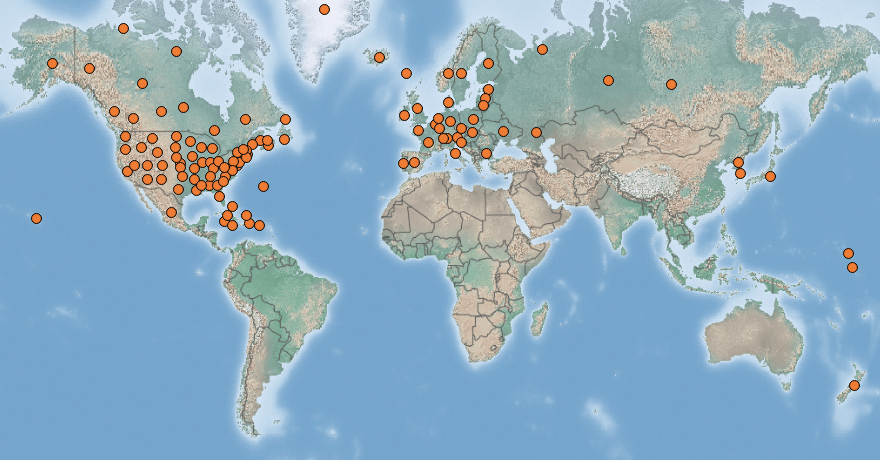 |
Mouflon |
Status LU: established. 1st record: 1905. |
 |
Mouflon[ref name=”DFL”]Derrmann-Loutsch, L., 2006. Dictionnaire Français-luxembourgeois. Luxembourg: Éd. Saint-Paul. 606 S. ISBN 978-2-87963-634-4[/ref], Muffel(-schof) |
Status Eur.: established. |
 |
Mouflon |
RA: ISEIA: C2. Harmonia+: n/a. |
 |
Mufflon |
Wikipedia:     | Wikispecies: | Wikispecies:  | CABI | CABI |
 |
Moeflon |
Back to the list of vertebrates |
Notes on taxonomy and nomenclature
On February 4, 2020, we changed the title of this page from Ovis ammon (Linnaeus, 1758) to Ovis aries musimon (Pallas, 1811) according to the CABI fact sheet: “Given that it is generally assumed that European mouflons are feral populations of ancient domestic stocks, it is advisable to denominate them taxonomically as Ovis aries (…), subspecies musimon, which is the name used in this datasheet, following ITIS (2016)” (CABI 2016). For more details read the detailed “Notes on Taxonomy and Nomenclature” in the CABI fact sheet (CABI 2016).
The distribution of the species at GBIF is split due to the use of several synonyms, e.g. Ovis ammon (Linnaeus, 1758) (GBIF 2020a) and Ovis aries musimon (Pallas, 1811) (GBIF 2020b).
Other scientific names in use in Luxembourg
- Ovis ammon (Linnaeus, 1758) [used in: Ries et al. 2014; Schley & Herr 2019]
- Ovis ammon musimon (Pallas, 1811) [used in: Massard & Kintziger 1994]
Brief description

Mouflons in a wildlife park in the Eifel (Rhineland-Palatinate, Germany) in August 2008
The European mouflon is the westernmost and smallest sub-species of mouflon. It was originally found only on the Mediterranean islands of Corsica and Sardinia, but has since been introduced into many other regions of Europe (Wikipedia contributors 2020).
The European mouflon is a small sheep, particularly compared to its Asian relatives and to some domestic breeds. Sexual dimorphism is present, with males weighing about 30% more than females. Both sexes can exhibit horns, although not all females (and none in the Sardinian population) do. The horns of males can be up to 60 cm long and are curved into a circle. The coat colour is reddish-brown; darker in winter, when males have a black mane with whitish tones on the snout, the ventral area and the distal part of the legs (Asian mouflon from Asia Minor and Iran have more distinct colours). The whitish tones of the face increase with age. The anal white coat is well marked. The tail is black and short. Mouflons have thick skin and wool; the dense winter coat is shed in spring. Males are more robust than females and possess long hair on the neck, chest and front of the forelegs; they also show a characteristic side spot, the “saddle”, of whitish tones, which is much less marked in females (CABI 2019).
The European mouflon is a wild sheep that originates from the Mediterranean islands of Corsica and Sardinia; it is thought to be descended from semidomesticated wild sheep from the Near East brought to Sardinia around 8000 years ago. It has been introduced to many countries in Europe and some elsewhere, mostly as a quarry species for hunting; the extent to which populations have become established or increased varies from country to country. In most countries there is little evidence of serious adverse effects (although there has been little research on the subject), but the mouflon is considered invasive in Hawaii and the Canary Islands, where it has had serious adverse effects on native vegetation (CABI 2019).
As early as the 18th century mouflons were introduced in various regions of Europe (Niethammer 1963 cit. in: Massard & Kintziger 1994: 187).
Health issues of mouflons outside their home range
Mouflon are a longstanding matter of concern in most regions outside their home range. Not well adapted to most of the habitats where they have been released, many animals are suffering from problems with their hooves (foot rot, hoof overgrowth; Piegert & Uloth 2000) (Apollonio et al. 2010).
In the case of the mouflon, NABU North Rhine-Westphalia demands that this non-native species be completely shot down for reasons of nature conservation and animal protection, because the individuals, optimally adapted to life on rocky islands, develop hoof problems as a result of the soft soils prevailing here. Their hooves often grow extremely long and cause considerable pain. They also increase the pressure on the natural growth in the forest. Furthermore, mouflons damage rare biotopes such as rocky heads (NABU, 2020).
Examples from 2 regions:
- Bavaria: The mouflon is not very well adapted to the living conditions prevailing in Bavaria. Thus, the animals often suffer from serious claw diseases on the softer soils in our country (Wildtierportal Bayern 2020).
- Switzerland: The free mouflon lives in forested areas, from the lowlands to the mountains. It needs hard and stony soils to grind down its fast growing hooves. In the wildlife park this is made possible by stone fields, as otherwise deformities and infections can develop (Wildpark Mühletäli 2020).
Status and distribution in Luxembourg
Currently, mouflons are present in three areas of Luxembourg: the Our valley, the northern Upper Sûre area and around Heffingen/Echternach (Massard & Kintziger 1994; Schley & Herr 2019: 34).
A former population in the Meysembourg area is extinct (Lux 2005). The grand ducal compound (“Gatter”) at Grünewald near Imbringen was opened to the public in 2009 (SPC 2020).
A male mouflon was run over near the animal park “Escher Déierepark” at Gaalgebierg in Esch-sur-Alzette in 2012 (MNHNL 2000-), it can be assumed it was an escaped animal.
The mouflon in the regions of Luxembourg
Grand ducal compound at Grünewald (1905-2009)
Since 1905 mouflons were kept in the grand ducal compound in Grünewald near Imbringen, municipality of Junglinster (Massard & Kintziger 1994). Several animals have been introduced in 1905 from a game park near Wiesbaden, Germany (Massard & Kintziger 1994: 188; Lux 2005). According to Decker (1979), a second batch of mouflons entered Luxembourg in 1921: six animals from Het Loo (NL) (cit. in: Massard & Kintziger 1994: 188). In 1953, most of the grand ducal mouflons were sold (e.g. to Spain), but at the same time a few other mouflons were imported from the enclosure of the Duke of Bavaria (Decker 1979).
The cited sources don’t mention if this population still existed in the 1990ies. The grand ducal compound in Grünewald (nicknamed “Gatter”) was opened to the public on 9 April 2009, following the agreement of 16 January 2009 between the Luxembourg State and the grand ducal administration (SPC 2009).
Upper Sauer region (1970-)
In 1968, on the proposal of the High Council for Hunting, the Minister of the Interior instructed the Water and Forestry Administration to prepare the introduction of mouflons into the Luxembourg natural environment in the Kaundorf region. In 1970, 14 animals were released into the natural environment near Kaundorf. Since then, and until the beginning of the 1990s, the population has been steadily increasing due to the rather restricted shooting plan: the population numbers about 200 animals and has proliferated over an area of about 9,000 ha. In 1994, in view of the poor health situation of the herd and the numerous damages caused to the forest, the mouflon hunt was widely opened and the shooting plan was abolished. In the 2000s, the population stabilizes at about 60 individuals (spring counting) (Lux 2005).
In 1992, the population was estimated at 100-120 animals living in the area around the barrier lake of the Upper Sauer (Massard & Kintziger 1994).
Our valley near Hosingen (1970-)
The mouflon population around Hosingen originates from the former wildlife park “Wildpark Hosingen”, which existed between 1970 and 1984 and where deer, wild boars, fallow deer, mouflons, mountain goats and indigenous bird species were introduced to visitors in enclosures on an area of around 150 hectares (SISPOLO 2015).
The park had financial problems from 1983 (Lux 2005) and shut down in 1984. This was followed by the escape of some of the animals (fallow deer and mouflons). In the 2000s, the mouflon population numbers about 30 individuals (spring counting) (Lux 2005).
Meysembourg aera (1972-1993)
A mouflon enclosure was established in Meysembourg in 1972. Shortly afterwards, several animals fled and settled in the Christnach/Heffingen region. In the 1980s, the population numbered about 100 animals. In 1984, severe barking damage was noted, followed by a wide opening for hunting from 1985 onwards. In 1993 the population became extinct (Lux 2005).
Echternach aera (1995-)
As far as the Echternach region is concerned, there is a strong presumption of illegal releases (Lux 2005):
- In October 1995, first appearance of moufflons in the “Haardt” forest near the lake of Echternach, their origin being unknown (120 animals). In winter 2003/04, the Haard population amounts to ± 160 animals.
- In October 1996, first appearance of moufflons near the Mélickshaff and in Kalkesbaach near Consdorf, their origin also unknown (20 animals). February 2005: 16 animals.
- In December 1996, first appearance of moufflons at Seiterhof near Berdorf, also unknown provenance (20 animals). February 2005: 70 animals.
At the end of February 2005, a new population count by the Water and Forestry Administration (before the calving) indicates that the mouflon population in the region before the calving in March 2005 was 264 head. The female sex predominates in the composition of the herds in the Echternach region. Based on observations in recent years, it can be said that the population always increases by one third after giving birth. The population in the Echternach region should therefore have reached the current level of ± 350 animals (Lux 2005).
Schley & Herr (2019: 34) confirm that the mouflon population in the area around Heffingen/Echternach originates from an illegal release. In 2020, there is estimated to be between about 100 (Anonyme 2020) and 200 (Magar 2020, ota 2020) mouflons in that region.
Estimated damages caused by mouflon
The mouflons cause different kinds of damage. For example, the following damage can currently be seen in the Echternach region (Lux 2005):
- debarking of trees, especially spruce trees;
- spike grazing in leaf plantations and natural regeneration;
- damage to agricultural crops;
- disturbance of native deer by non-native mouflons.
In the summer of 2003, an inventory was carried out in the canton’s forests of Echternach, to determine the debarking damage caused by the mouflons, resulting in a damaged area of 18,79 ha. The damaged species are mainly spruce and Douglas fir, the hardwood species are less affected by debarking. Recently it has also been observed that natural regeneration of beech has been damaged by mouflons (bud browsing) (Lux 2005).
In 2020, in the press, various statements are made about the damage caused by muffled animals:
- lessentiel.lu: There is estimated to be about 100 mouflons in that region and the damage they cause is estimated at 31.814,77 euros, as well as the prevention of forest regeneration (Anonyme 2020).
- wort.lu: Yves Wengler (CSV), mayor of Echternach, estimates that the 200 or so mouflons living in the woods of his commune caused damage of 100.000 euros (ota 2020).
Management
Mouflon hunt in Luxembourg
The addition of the administrative hunt to the law on hunting
Note: this chapter is an excerpt of the answer of Lucien Lux (2005) to parliamentary question n°377.
Since the first appearance of mouflons in the region of Echternach in 1995, the administration of Water and Forests has been very concerned about this presence. Since the mouflon is not a native species and there are no other populations of this species in the region, it soon became clear that the population could only be the result of clandestine or even illegal releases, without it having been possible so far to establish who was responsible.
As the sheep population continued to grow, on the initiative of the Minister of the Environment two meetings were held in autumn 2003 with tenants and representatives of the hunting unions in the Echternach region to find a solution to the worrying situation. At these meetings, the final goal was clearly formulated, namely to achieve a “zero” mouflon population within a reasonable period of time (5 years) by means of hunting. To this end, the Water and Forestry Administration had developed various models for reducing the population. The following recommendations were made to hunting tenants: priority should be given to shooting female animals and an attempt should be made to reduce the population by more than half in the first hunting year. This proposal was accepted by the representatives of the unions and the hunters, and voluntary commitments were signed by all hunting tenants.
At the end of winter 2004/05 (March 2005), the Water and Forestry Administration analysed the current situation and drew up an interim assessment of the commitments made by the hunting tenants. It turned out that the situation has not improved at all, but on the contrary has worsened. Although some hunting tenants have made an effort to shoot as many animals as possible, this does not seem to be the case for others. Indeed, recent counts carried out by the Water and Forestry Administration at the end of February 2005 show that the combined effort of all hunting tenants has been absolutely insufficient.
The current hunting legislation does not confer any right of direct intervention by either the Ministry of the Environment or the Water and Forests Administration to reduce a game species once the animals are in a state of natural freedom. The Government is therefore relatively powerless in the face of this situation and must confine itself to recommendations.
This is why the Minister of the Environment recently tabled a bill amending the hunting legislation and including the following point: introduction of the right of initiative for the State with a view to organizing administrative hunting under certain well-defined conditions, alongside the right of initiative of the hunting syndicate, which is to be maintained. The conditions which must be met before the administrative hunting procedure can be initiated are as follows:
- high concentrations of game, as evidenced by the presence of crop damage;
- unauthorised releases of animal species, whether or not they are classified as game;
- control of epizootic diseases.
Legal aspects
The law of 25 May 2011 on hunting (Mémorial 2011) stipulates:
- Art. 10. Shooting with a bullet is obligatory for the hunting of deer, roe deer, wild boar, mouflon and fallow deer (Mémorial 2011: 1729).
- Art. 13. The hunting of deer, wild boar, roe deer, fallow deer and mouflon may be subject to a shooting plan. This plan determines the number of animals, distributed according to their species, type, age or sex, which must or may be shot on a given territory during a given period. / A Grand Ducal regulation determines the procedures for drawing up the shooting plan, the species of game covered by it, the duration of the plan and the related control measures (Mémorial 2011: 1729).
- In the annex to the Act, the ‘mouflon (Ovis musimon)’ is considered to be a species belonging to the wild fauna and classified as ‘large game’ alongside deer (Cervus elaphus), roe deer (Capreolus capreolus), wild boar (Sus scrofa) and fallow deer (Dama dama) (Mémorial 2011: 1741).
Hunting statistics
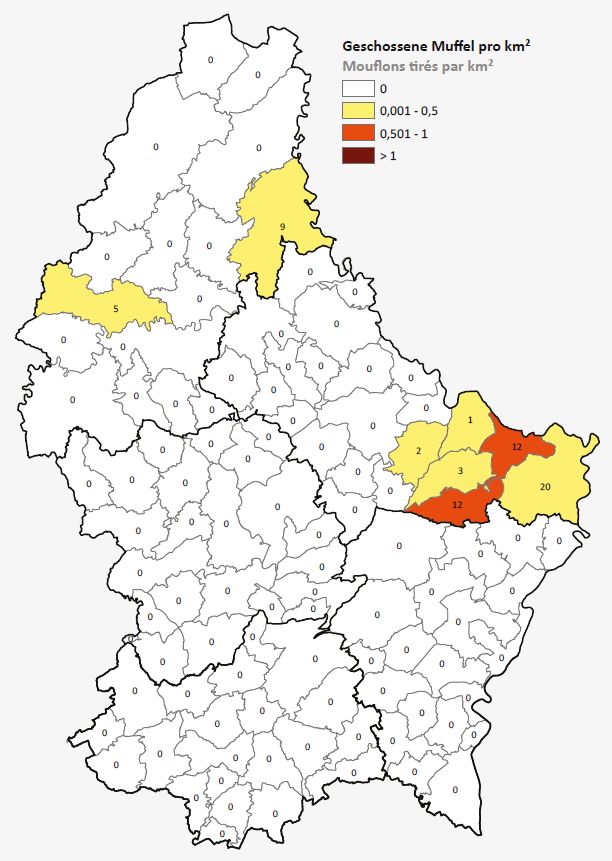
Mouflons shot per km² in the hunting season 2017-2018 (Schley & Celllina 2018: 25)
Hunting statistics show that the number of hunted mouflons has been increasing from around 20 in the late 1980s to over 150 since 2000, with a peak of 250 during the hunting season 2009/2010 (Naturverwaltung 2012). Since then, the number of shot animals decreased to about 75 in 2013/2014 (Naturverwaltung 2014) and stayed at a similar level in the hunting season 2017-2018 (Schley & Celllina 2018: 9). Schley & Herr (2019: 35) state that about 100-150 mouflons are shot in Luxembourg every year.
The geographical distribution of shot mouflons for the hunting year 2017/18 (see map on the right) is in line with the mouflon distribution (see above) based on data from Recorder-Lux, GBIF and iNaturalist (MNHNL, iNaturalist & GBIF 2020).
Administrative hunt in 2020
In February 2020, the Ministry of the Environment planed an administrative hunt for mouflons in the Echternach region which was not carried out yet (2020-03-12). End of 2019, the Higher Council for Hunting (Conseil supérieur de la chasse) had given the go-ahead for this hunt (Magar 2020).
The public debate on mouflon in Luxembourg
Parliamentary questions
- 2005-03-29: Question écrite n°377 [PDF]. Sujet: Mouflon. Auteur : Monsieur Jos Scheuer, Député. Auteur de la réponse: Monsieur Lucien Lux, Ministre de l’Environnement (Lux 2005) [PDF].
- 2006-06-20: Question écrite n°1124 [PDF]. Sujet: Présence du mouflon sur le territoire du Luxembourg. Auteurs: Monsieur Marco Schank, Député; Monsieur Marcel Oberweis, Député; Madame Françoise Hetto-Gaasch, Députée (Hetto-Gaasch et al. 2006). Auteur de la réponse: Monsieur Lucien Lux, Ministre de l’Environnement (Lux 2006) [PDF].
- 2019-10-28: Question écrite n°1402 [PDF]. Sujet: Colonies de mouflons. Auteur: Monsieur Marc Goergen, Député (Goergen 2019a). Auteur de la réponse: Madame Carole Dieschbourg, Ministre de l’Environnement, du Climat et du Développement durable (Dieschbourg 2019) [PDF].
- 2019-12-18: Question écrite n°1623 [PDF]. Sujet: Colonies de mouflons. Auteur: Monsieur Marc Goergen, Député (Goergen 2019b). Auteur de la réponse: Madame Carole Dieschbourg, Ministre de l’Environnement, du Climat et du Développement durable (Dieschbourg 2020a) [PDF].
- 2020-01-22: Question urgente n°1746 [PDF]. Sujet: Chasse au mouflon. Auteur: Monsieur Marc Goergen, Député (Goergen 2020a). Auteur de la réponse: Madame Carole Dieschbourg, Ministre de l’Environnement, du Climat et du Développement durable (Dieschbourg 2020b) [PDF].
- 2020-03-02: Question urgente n°1961 [PDF]. Sujet: Chasse aux mouflon. Auteur: Monsieur Marc Goergen, Député (Goergen 2020b). Destinataire: Madame Carole Dieschbourg, Ministre de l’Environnement, du Climat et du Développement durable.
Social media
From the end of February 2020 onwards, the debate surrounding the mouflon hunt was the subject of controversy, hateful debates and excesses on social networks in Luxembourg.
On February 28 2020, the political party “Piratepartei Lëtzebuerg” posted a video on its Facebook account criticising the Minister of the Environment, Climate and Sustainable Development Carole Dieschbourg for her position in the hunt for mouflons (Piratepartei Lëtzebuerg 2020; Pautsch 2020).
Following a series of hateful and threatening comments against her, Carole Dieschbourg announced on 4 March 2020 via her Facebook account to take legal action (Dieschbourg 2020c; Frati 2020).
Risk assessment
ISEIA protocol
C2 (3+2+1+1) (Ries et al. 2014: 199).
Harmonia+ protocol
Not assessed yet.
Worldwide distribution
Bibliography
- Anonyme, 2020. Le Luxembourg veut chasser les mouflons. L’Essentiel, 17 décembre 2019. http://www.lessentiel.lu/fr/luxembourg/story/le-luxembourg-veut-chasser-les-mouflons-18262683
- Apollonio, M., R. Andersen & R. Putman, 2010. European ungulates and their management in the 21st century. Cambridge University Press, Cambridge, UK ; New York. 604 p.
- Bingenheimer V., 2018. Eine unangenehme Wahrheit – Trotz massiver Abschüsse vermehren sich die Mufflons im Wald bei Echternach ungebremst. Luxemburger Wort 3. April 2018: 18-19. [PDF 4.3 MB]
- CABI, 2019. Ovis aries musimon Pallas, 1811 [original text by Jorge Cassinello]. In: Invasive Species Compendium. Wallingford, UK: CAB International. URL: www.cabi.org/isc [accessed 2019-11-22]
- Decker, P. 1979. Die Einbürgerung von Mufflons in Luxemburg. Direction des eaux et forêts, Rapport non publié, 8 p.
- Dieschbourg, C., 2019a. Réponse de la Ministre de l’Environnement, du Climat et du Développement durable à question N°1402 de Monsieur Marc Goergen concernant Colonies de mouflons. Q-2019-O-E-1402-02. [chd.lu]
- Dieschbourg, C., 2020a. Réponse de la Ministre de l’Environnement, du Climat et du Développement durable à question N°1623 de Monsieur Marc Goergen concernant Colonies de mouflons. Q-2019-O-E-1623-02 [chd.lu]
- Dieschbourg, C., 2020b. Réponse de la Ministre de l’Environnement, du Climat et du Développement durable à question N°1746 de Monsieur Marc Goergen concernant Chasse au mouflon. Q-2019-O-E-1746-02 [chd.lu]
- Dieschbourg, C., 2020c. Post on Facebook, 2020-03-04, 09:38. URL: https://www.facebook.com/DieschbourgCarole/ [accessed 2020-03-12]
- Frati, C., 2020. La justice saisie / Carole Dieschbourg ciblée par des messages haineux. paperjam online 2020-03-04. URL: https://paperjam.lu/article/dieschbourg-prend-mouflon-par- [accessed 2020-03-12]
- GBIF, 2020a. Ovis ammon (Linnaeus, 1758) in GBIF Secretariat (2019). GBIF Backbone Taxonomy. Checklist dataset https://www.gbif.org/species/2441122 [accessed 2020-02-04]
- GBIF 2020b. Ovis aries subsp. musimon (Pallas, 1811) in GBIF Secretariat (2019). GBIF Backbone Taxonomy. Checklist dataset https://www.gbif.org/species/6165157 [accessed 2020-02-04]
- Goergen, M., 2019a. Question N°1402 de Monsieur Marc Goergen concernant Colonies de mouflons. Q-2019-O-E-1402-01 [chd.lu]
- Goergen, M., 2019b. Question N°1623 de Monsieur Marc Goergen concernant Colonies de mouflons. Q-2019-O-E-1623-01 [chd.lu]
- Goergen, M., 2020a. Question N°1746 de Monsieur Marc Goergen concernant Chasse au mouflon. Q-2019-O-E-1746-01 [chd.lu]
- Goergen, M., 2020b. Question N°1961 de Monsieur Marc Goergen concernant Chasse aux mouflon. Q-2019-O-E-1961-01 [chd.lu]
- Hetto-Gaasch, F., M. Oberweis & M. Schank, 2006. Question N° 1124 de Mme Françoise Hetto-Gaasch et M. Marcel Oberweis et M. Marco Schank concernant Présence du mouflon sur le territoire du Luxembourg. Q-2005-O-E-1124-01 [chd.lu]
- ITIS, 2016. Integrated Taxonomic Information System online database. http://www.itis.gov
- Lux, L., 2005. Réponse du Ministre de l’Environnement à la question parlementaire no. 377 de Monsieur le député Jos Scheuer. 2005-04-18.
- Lux, L., 2006. Réponse du Ministre de l’Environnement à la question N° 1124 de Mme Françoise Hetto-Gaasch et M. Marcel Oberweis et M. Marco Schank concernant Présence du mouflon sur le territoire du Luxembourg. Q-2005-O-E-1124-02 [chd.lu]
- Magar, M., 2020. Une première chasse au mouflon au Luxembourg. L’essentiel 10 janvier 2020. URL http://www.lessentiel.lu/fr/luxembourg/story/une-premiere-chasse-au-mouflon-au-luxembourg-31427844 [accessed 2020-03-06]
- Massard, J.A. & P. Kintziger, 1994. Le Mouflon (Ovis ammon musimon) au Luxembourg: notes historiques sur son introduction et analyse de la population des mouflons de la région de la Haute-Sûre. Bull. Soc. Nat. luxemb. 95: 187-208. [PDF 1058 KB]
- Mémorial 2011. Loi du 25 mai 2011 relative à la chasse. Mémorial A, 111: 1727-1741.
- MNHNL, 2000-. Ovis ammon in Recorder-Lux, database on the natural heritage of the Grand Duchy of Luxembourg. Musée national d’histoire naturelle, Luxembourg. URL: https://mdata.mnhn.lu [Accessed 2020-02-04]
- MNHNL, iNaturalist & GBIF, 2020. MNHNL-mdata, online portal combining species observation from Recorder-Lux, iNaturalist and GBIF. National Museum of Natural History, Luxembourg. URL: https://mdata.mnhn.lu [Accessed 2020-02-04]
- NABU, 2020. Das Mufflon. NABU Nordrhein-Westfalen. URL: https://nrw.nabu.de/natur-und-landschaft/landnutzung/jagd/jagdbare-arten/weitere-saeugetiere/06783.html [accessed 2020-03-09]
- Naturverwaltung (ed.), 2012. Technischer Bericht der Naturverwaltung betreffend Wildtiermanagement und Jagd, Nummer 2 (2012), 68 pp.
- Naturverwaltung (ed.), 2013. Jagbare Wildtierarten Luxemburgs. 96 pp.
- Naturverwaltung, 2014. Bulletin technique de l’Administration de la nature et des forêts en matière de gestion de la faune sauvage et de chasse, numéro 3 (2014), 72 pp.
- Niethammer, G., 1963. Die Einbürgerung von Säugetieren und Vöglen in Europa. Ergebnisse und Aussichten. Hamburg, P. Parey, 319 p.
- ota, 2020. Carole Dieschbourg menacée de mort. Online article on wort.lu. URL: https://www.wort.lu/fr/luxembourg/carole-dieschbourg-menacee-de-mort-5e60d048da2cc1784e3579c9 [accessed 2020-03-06]
- Pautsch, M. 2020. Facebook / Carole Dieschbourg schaltet wegen Kommentaren mit Morddrohungen Autoritäten ein. Tageblatt online, 2020-03-05. URL: https://www.tageblatt.lu/headlines/carole-dieschbourg-schaltet-wegen-kommentaren-mit-morddrohungen-justiz-ein/?fbclid=IwAR0L6ONV1fONfskNmxVMZ23VsB9wp-sIpvbXtAEQQi59HegKnS7s5kfy5V8 [accessed 2020-03-12]
- Piegert, H. & W. Uloth, 2000. Der Europäische Mufflon. Hamburg. 280 p.
- Pir, J.B. & L. Schley, 2015. Développement des connaissances sur la répartition et l’écologie des mammifères au Luxembourg entre 1990 et 2015. Bull. Soc. Nat. luxemb. 116: 437-455.
- Piratepartei Lëtzebuerg, 2020. Video on Facebook, 2020-02-28, 22:02. URL: https://www.facebook.com/Piratepartei/videos/2508661829350143/ [accessed 2020-03-12]
- Ries, C., M. Pfeiffenschneider, Engel, E., J.-C. Heidt & M. Lauff, 2014. Environmental impact assessment and black, watch and alert list classification after the ISEIA Protocol of vertebrates in Luxembourg. Bull. Soc. Nat. luxemb. 115: 195-201. [PDF 247 KB]
- Scheuer, J., 2005. Question N° 0377 de M. Jos Scheuer concernant Mouflon. Q-2004-O-E-0377-01 [chd.lu]
- Schley, L. & J. Herr, 2019. Säugetiere Luxemburgs. Hrsg.: natur&ëmwelt a.s.b.l., Ministère du développement durable et des infrastructures, Administration de la nature et des forêts. 219 S. ISBN 978-2-9199511-0-9 [French edition: Les mammifères du Luxembourg, ISBN 978-2-9199511-2-3]
- Schley, L. & S. Cellina, 2018. Technischer Bericht der Naturverwaltung betreffend Wildtiermanagement und Jagd, Nr. 7, 52 S. Administration de la nature et des forêts, Diekirch. [PDF 13 MB]
- SISPOLO, 2015. Historischer Überblick der Aktivitäten und der Entstehung des SISPOLO-Syndikats. URL: https://www.sispolo.lu/geschichte-1.html [accessed 2020-03-06]
- SPC, 2009. Ouverture au public de la forêt du Grünewald. 09-04-2009. Service Presse et Communication. URL: http://www.monarchie.lu/fr/actualites/evenements/2009/04/Grunewald/index.html?highlight=Gr%C3%BCnewald [accessed 2020-03-12]
- Wildpark Mühletäli, 2020. Mufflon / Europäisches Wildschaf. URL: http://www.wildpark-muehletaeli.ch/tiere-im-park/mufflon/ [accessed 2020-03-09]
- Wildtierportal Bayern, 2020. Muffelwild. URL: http://www.wildtierportal.bayern.de/wildtiere_bayern/096779/index.php [accessed 2020-03-09]
- Wikipedia contributors, 2020. ‘European mouflon’, Wikipedia, The Free Encyclopedia, 18 January 2020, 21:49 UTC, <https://en.wikipedia.org/wiki/European_mouflon> [accessed 2020-02-04]
Page content last updated on 2025-10-22. Last proofread by Caroline Grounds on 2020-02-05.







 | Wikispecies:
| Wikispecies:  | CABI
| CABI

 Invasion
Invasion
 Impact
Impact
 Risk
Risk

